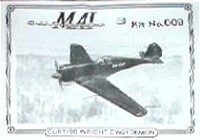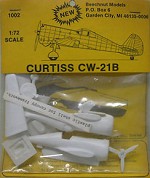MPM 1/72 Curtiss-Wright CW-21B Interceptor

I still have to write a proper introduction, but I couldn't resist adding this piece of highly interesting information about the CW-21 that I found here. I had always thought that the CW-21 was quite inferior to the A6M Zero that the Japanese flew when they invaded the Dutch East-Indies, and that this explained the very limited success of the Demon/Interceptor. But former Flying Tigers pilot Erik Shilling notes: "I have flown a CW-21, an aircraft built by Curtiss Wright in 1938 that's empty weight was 3150 lbs which was 10 mph faster than the Zero, could out climb the Zero by more than 2500 fpm, and 100 mph faster in a dive faster and had a higher role rate as well. Why didn't the military buy it. Just dumb I guess." So, the tiny CW-21B was a quite capable fighter! Erik Shilling was one of the pilots of the small number of CW-21's that were delivered to China, but all crashed en route.
History overtook this project: in 2022, Special Hobby issued a new CW-21 model (catalog number SH72436), and in 2025, Dora Wings will issue a scaled-down version of their 1/48 model (catalog number DW72cw21). I prefer to build one of these new models instead of an old limited-run model like this MPM kit.
|
What's it callled?
The CW-21 is now usually called Demon, but that name only surfaced after the war, and mistakingly based on an abbreviation of 'demonstrator' for the first CW-21. A publicity photo from 1939 reports: 'The new plane, called the CW21 Interceptor Fighter, climbs ...'. The short version, Interceptor, was also (apparently) used by ML-KNIL.
The 1/72 MPM model
The CW-21B is a typical MPM limited run kit. The parts are relatively thick, some minor mould damage is apparent (pits, dents, parts of the mould broken off), but overall it is very buildable. The canopy is quite thin, but not completely smooth. A small photo-etch fret contains mainly cockpit parts. The decals look good to me, and give the builder a set of ML-KNIL markings (with enough numbers for every CW-21B used), and a Japanese captured example (see MIP article or this page). A build report by Caz Dalton on his homepage, unfortunately no longer available, reported that the white decals are opaque (enough?), MPM nevertheless provides a double set. The orange parts however were translucent, and the white line showed through. Alternatives are available, as listed below.
I started building my MPM kit without worrying too much about the model's accuracy. After some time I got a better grip on the CW-21B, and slowly started to see some more errors. Here's an attempt at listing the kit's problems:
My first interest was whether the front fuselage is correct. After studying all available photographs, I'm now convinced that the cowling tapers fairly strongly, followed by a kink, and the rest of the fuselage tapers much less. Note that the kink only applies to the sides of the fuselage, and not to the top of the fuselage. MPM has taken a half-hearted approach: the right side has a shallow kink, and the left side doesn't have a kink at all ! I plan to make some smart saw cuts here and there to create a much more distinctive kink
The fuselage's lower side is too square behind the cockpit. MPM created too small wing root fillets, and made the fuselage more square to make things fit. The fuselage has to be rounded more there, and the wing root fillet has to be enlarged
MPM's wing root fairing connects in a curved line to the front fuselage. Photos show however that a large part of the fairing connects to the front fuselage in a straight line, somewhat higher than on the model. At the front the fairing curves down, and at the rear is has a more complicated shape than MPM thought, and is longer
Similarly, the wing root fairing has a straight edge where it connects to the wing, and not in a curved line as the MPM fairing. I don't know about the forward 10-15% though
It is possible that MPM's windshield slopes too shallow, which makes a too long windscreen. This has to be checked
The model's gun hatch in front of the cockpit is rectangular. On the real aircraft the forward and rear sides are curved
The wing planform appears quite accurate to me. The span agrees closely with the published value of 35' 0". I did not find the root and tip chords, but the wing area agrees closely with known figures, so my guess is that both chords are correct. I haven't found a value of the wing dihedral yet
The wing thickness is too large. I found that the wing has a NACA 23015 profile at the root, a NACA 23009 at the tip, and an unknown 'C-W X' profile in the middle. The kit has a 22% thickness at the root however, instead of 15%, in other words it is 50% too thick. I haven't measured the tip yet
The vertical tail is missing an offset to the left. The only source that shows it clearly is the cutaway drawing however. The fin-rudder connection is very flush and featureless, whereas the real thing had a much more pronounced 3D shape
Caz Dalton's report mentioned that the cowling ring is oversize, and required lots of sanding. I suggest cutting out a small part of the ring, and gluing the ends together again
I think that correcting these errors is quite manageable, and it will be fun to do (I like doing some work of my own to a model). On the other hand, the Beechnut model could be a better starting point. Henk Jan Donker's analysis of other CW-21B models added some other areas that need checking, such as the cockpit size and location.
Fellow IPMS-NL modeller Han Krol has completed the MPM CW-21B and reported the following problems:
The fit of the cowling ring is quite problematic. Han lined it up with the lower side of the fuselage and had to sand considerably at the top of the cowling. This removed the gun troughs and carburetor intake, which he had to rebuild
The kit's horizontal tails have a forward sweep that must be corrected with small plastic card wedges at the root
The cockpit should be painted aluminium, and not green zinc chromate. According to Han aircraft interiors were not painted at this time
The MPM decals are not correct. The size or style of the serial numbers is incorrect, and he did not like the triangles either. All were replaced with Dutch Decals
MPM's color matches are wrong. See the comments on the 'Camouflage en Kentekens' book
A discussion with fellow IPMS-NL modeller Huub van Dijk yielded further ideas. I had noted that the real aircraft had joints of overlapping sheet aluminium. I thought it would make a highly interesting model if this could be portrayed in 1/72, but I lacked an idea how to realise this. While discussing this aspect of the CW-21B, Huub suggested that strips of thin card could be glued on the model (covering the engraved panel lines), perhaps sanded a little thinner, and putty used to build up skin thickness. I think this could work very nicely. Ideally it should be combined with some subtle 'stressed skin' simulation. But perhaps this a few steps too many at once ..
On the newsgroup rec.models.scale, Jim Maas posted the following interesting points:
the top section of the sliding canopy was tinted, presumably green
the fuselage tapered so quickly aft of the cockpit that rails, parallel to the centerline, were needed on each side to give something for the canopy to slide on. In 1/48, I used a single staple, clipped off one end and drilled a hole in the fuselage to accept the other end
the windscreen had framing only at the outside borders. What looks like a frame on either side of the windscreen (at about the 10 o'clock and 2 o'clock positions) is actually the support for a rectangular piece of armored glass inside
Construction
| Instead of focusing on the details, I first want my models to have the correct overall shape. This often leads to long delays because it takes a lot of effort to study and correct. The MPM CW-21B has a few problem areas. First and most obvious is the fuselage shape between the front of the cowling and the cockpit. The model has an almost continuous taper between these points, whereas the Beechnut (right) and Rareplanes have a definite kink. The MPM model need to be corrected here. Note that I reduced the thickness of the cockpit sides with a factor of three or so.
| 
|
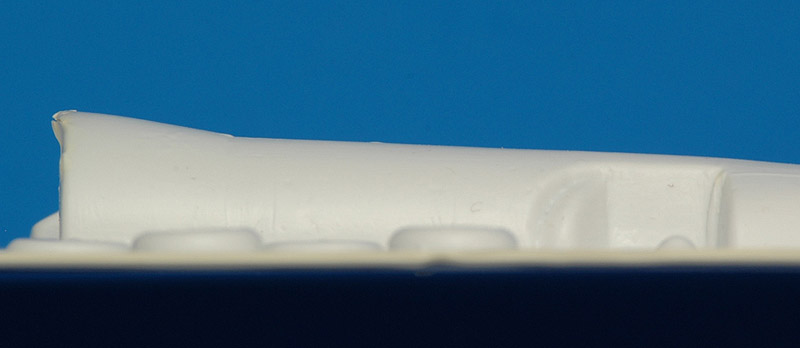
| Here I tried to photograph the same area of the Rareplanes fuselage, still on the sheet. The kink is clearly visible.
|
| The second shape problem is the fuselage shape below and behind the cockpit. MPM included part of the wing root fairing in the fuselage shape, and made it too square. Shown here is a comparison of the MPM and Beechnut models.
| 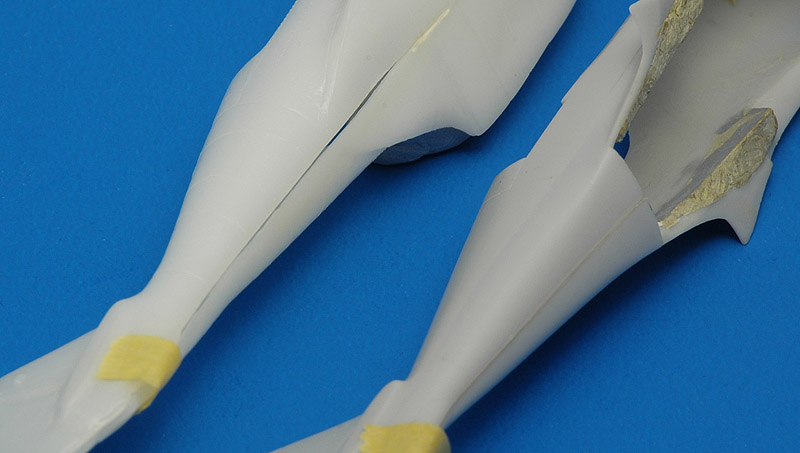
|

| The photo shows the same area of the MPM and Rareplanes models. I'm not so sure that the wing root fairing of the Rareplanes model is correct.
|
I worked on two areas so far. The model lacks wheel wells. I decided to add walls, although I don't have references to prove that the real thing had them. The cutaway drawing does show walls, but only if that drawing was made in the Curtiss factory, and not 40 years later, it can be considered a reliable source. I started with of with bending some 1 mm thick plastic card strips of 4 mm width around a pencil. I found a pen with a slightly smaller diameter than the wheel well opening, and used this as a stop to glue the curved strip millimeter by millimeter to the lower wing surface, using super glue. This process required four hands, but I had only two at hand. Next the straight sides were added. Some filler had to be employed at the lower wing - strip connection. And then came the process of fitting the new (oversized) walls to the upper wing surface. Step by step more material was removed from the strips, until it fitted snugly. In the middle I had to add a little filler. Then I removed just a little more, in order to be able to cover the wheel wells with 0.1 mm plastic card. This is necessary because the upper wing halves only cover part of the wells, and a crude piece is supposed to be used in the center. Even though this process is written down in a few sentences, it took quite a few hours in reality. The job is not yet done, because I want to add some stiffeners and details.
I later test-fitted the wheels in the wheel wells, and was very surprised when I noted that I could probably fit two wheels in each wheel well! This is largely caused by the 50% too thick wing, as I found out later. But changing the wing thickness involves large modifications, and is rather useless.
| 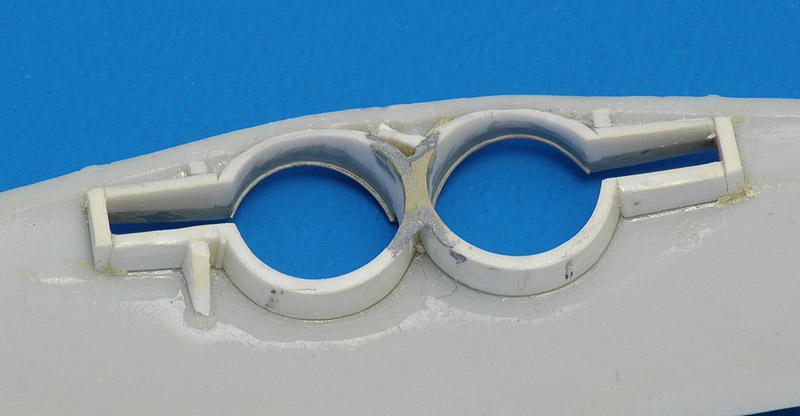
|
Next came the cockpit. As shown above, I thinned the walls with a factor of three or so, allow the construction of a more realistic cockpit interior later. The next step in the construction of the cockpit was to fill the lower sides of the cockpit walls, because MPM's wing root fairings created an opening there. Milliput was employed as a filler here. I will probably skip most of Eduard's photo-etch, and build the details with plastic strips, in order get a more three-dimensional interior.
To be continued
CW-21B models and accessories in 1/72 scale
Six models of the CW-21B are/were available in 1/72:
Rareplanes issued a vacform kit, kit number 01007, which can be built as the CW-21 prototype NX19441 or a CW-21B. I had an opportunity to inspect this model, unbuilt, in its packaging, courtesy of Hans Berfelo. Very noticeable is Rareplanes' concept of showing all rivets (even the flush ones) as engraved rivets. The complete model is done this way. This makes an extremely 'busy' model, which I didn't like much! Secondly I noted a much wider canopy, perhaps even 50% wider than the MPM canopy. I severely doubt whether this is correct. The fuselage shape behind the cockpit is a bit more circular, which looked better to me than MPM's highly elliptical shape. The fuselage shows a sharp kink at the cowling-fuselage transition, perhaps a bit too much. I liked the execution of the fin-rudder connection; this has a nice three-dimensional shape as opposed to the rather flush and featureless MPM tail. The wing root fillet looked more realistic to me (MPM's being too short). Jerzy-Wojtek shows his model on the Britmodeller forum, and Mitch K shows one under construction on the same forum.
MAI (Model Aire International) issued a resin kit (#009) with a vac canopy, possibly without decals, can be built as the CW-21 or the CW-21B. Discontinued in 1998. Tom Young of MAI wrote about it: 'Our (MAI) CW-21 was pretty bad, but you would really have to see what we had to start with! The master was so bad that we refused to pay the second half of the fee unless the guy did it right. Never heard from him again. The engine was far too big to fit in the cowling, trench like panel lines, about 75% had to be done over and we were still unhappy. Customers seemed to like it, but the arrival of the MPM kit was a relief.'
Beechnut produced a limited-run injection molded kit #1002 (Beechnut's second kit), issued in the late eighties in both a standard box and a bagged version. I had the opportunity to inspect this model briefly, inside its plastic bag. Although I had heard negative comments about Beechnut models in general, the model didn't look that bad to me. Many of the problems I found in the MPM model are represented correctly on this model. Examples are the correct representation of the kink in the front fuselage, the fuselage shape around the rear end of the wing root fairing, the roundness of the canopy, the straight connection of the wing and wing root fairing. I also noted that an engine with separate cylinders was included, plus some nice drawings in the instructions. Generally the small parts (such as wheels) looked similar to those in other short run models: the idea was great, the execution not so great. The model has engraved panel lines, possible a little too deep. One obvious problem of the model was the coarse surface of all parts; it looked like the master was made from wood with a very obvious and coarse grain. Sanding off this 'grain' will also make the panel lines look nicer. Of course I wasn't able to check the dimensions etc. I saw a vacform canopy, but did not study it closely. Although the parts may look reasonably good, putting it together is a different story, according to Quincy Seymour, who is slowly building this model. The engine is not very useful and best replaced, the cockpit has to be grinded out to make room for an interior, the landing gear bays have to opened and boxed in, and the parts don't fit well. Additionally you need a well stocked spares box and some scratch building experience.
MPM issued a limited-run injection molded kit, kit no 72073, as discussed on this page.
Merlin Models briefly produced a white metal CW-21, issued around 1988 together with a Curtiss R3C-2. I've seen the model (courtesy of Erwin Stam), and it was quite a shock. The parts are very thick and rather crude. You will probably wear out a few files while opening the cockpit, for example. The engine cowling opening was severely unround too. The injected canopy was not very clear, of a strange shape, and it looked very wide. The model represents the original CW-21 version with rearward retracting main landing gear. No decals are provided.
RVHP from the Czech Republic issued a resin CW-21, probably around 2002, with catalog number 7297. I think it is a full resin kit, but this page suggests it is only a conversion set. The box art shows a CW-21 with rearward retracting landing gear. I haven't seen the kit myself, but a review of the RVHP CW-22 (#7295) makes me cautious: it was a modified MPM CW-21. This makes it likely that the RVHP CW-21 is a backdated MPM CW-21B.
| The main components of the Beechnut kit. The parts are quite rough, and the wing parts have a wood print, which is kind of unique for an injection-molded kit! If you look through the roughness, a reasonably nice kit hides underneath, that is often more accurate than the MPM model.
| 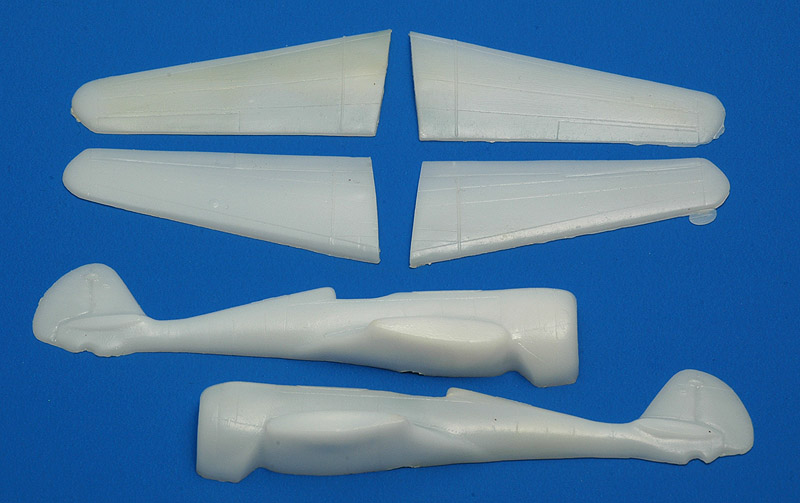
|

| The small components of the Beechnut kit. There's no guarantee it's complete, since I bought the kit as an unmarked bag of parts, without instructions. The limitations of the production process are quite obvious. In case your're wondering: the parts on the top right are nine cilinders and a crankcase. And I'm still wondering what slight below the center is - maybe a torque scissor for the landing gear? Most are best replaced by spares parts, or scratchbuilt. The vacformed canopy is too rough to use.
|
| A close-up of the fuselage shows delicate riveting on the sides and what I believe a largely correct shape. The vertical tail is very thick.
| 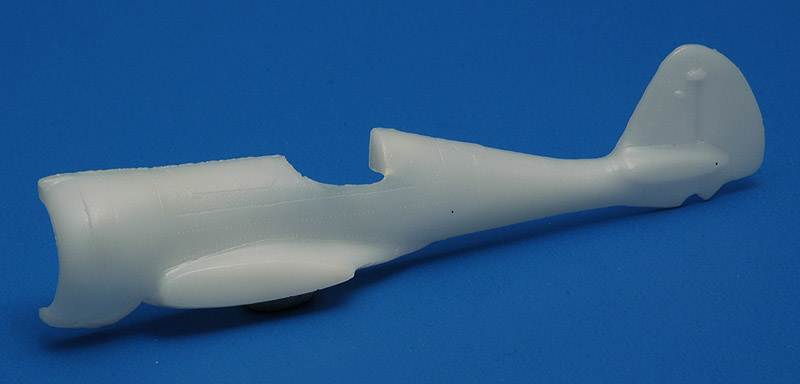
|
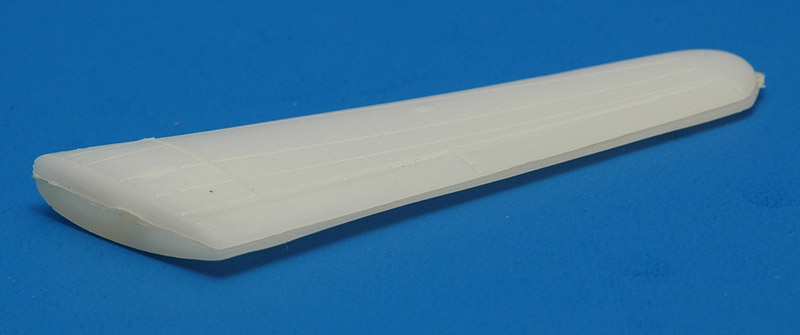
| The left wing shown upside down. The profile thickness looks excessive to me, similar to the MPM wings.
|
| The Rareplanes model consists of one sheet of vacformed parts. The fuselage halves show very nice and delicate rivet detail. The wings are drowned in rivets, as if every stiffener is represented. I don't think it will look realistic.
| 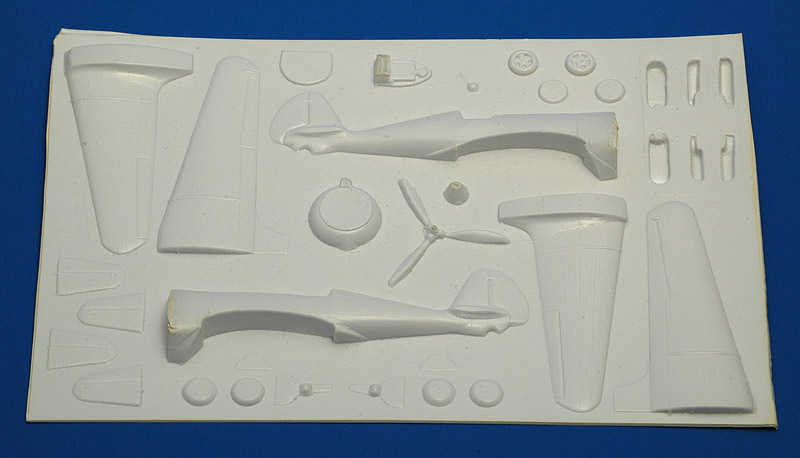
|
I found the following 1/72 accessories:
Wright R-1820-G5 engine:
Engines & Things #72074 Wright R-1820G-100 (for B-17 series) in resin, about 2 US$. Another site is this one: Engines & Things (Canada)
Aeroclub #E025 Wright R-1820G series Cyclone, about 2.25 US$ (white metal I think)
Aeroclub #E021 Wright R-1820F series Cyclone (could be different from the G-series)
propeller:
decals:
Dutch Decal sheet 72038 contains decals for ML-KNIL CW-21Bs
Sierra Scale, who make the 1/48 CW-21B kits, also offer a 1/72 version of their 1/48 sheet (72-204)
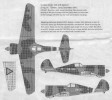
 Tally Ho! sheet 7008 contains decals for aircraft CW-357 or 359 (you can't do both). Note that this the Canadian Tally Ho!, not the Czech firm. Tally Ho! decals are small sheets with excellent instructions. Although not much is heard from Tally Ho, they are still in business and can be contacted at tallyho.decals@home.com or via PO Box 2338 Sidney, BC, V8L 3W6, Canada
Tally Ho! sheet 7008 contains decals for aircraft CW-357 or 359 (you can't do both). Note that this the Canadian Tally Ho!, not the Czech firm. Tally Ho! decals are small sheets with excellent instructions. Although not much is heard from Tally Ho, they are still in business and can be contacted at tallyho.decals@home.com or via PO Box 2338 Sidney, BC, V8L 3W6, Canada
CW-21B models and accessories in 1/48 scale
In 1/48 four models are/were available:
Sierra Scale produced two variants of their CW-21B model. Initially a full-resin model of 28 parts with 10 white metal parts and 2 vac formed canopies (catalog number 48-R1) was produced, costing approximately 50 US$. It proved to be too difficult to produce, and was converted to a traditional vacform model with some resin and white metal parts (catalog number 48-43, 28 US$), Both come with a small Microscale decal sheet. The kits are reported to be of excellent quality, although one review (Fine Scale Modeler, March 1994 issue) reported the kit was about one foot too short in both span and length. But another reviewer measured a perfect span. The FSM reviewer did not like the kit decals, the serials being overscale and insignia ragged. Modeling Madness has a review
Karo-As from Germany, #KA48-08, resin, 120 DM. From the mid 1990s Karo-As worked together with WSW (see below) who did the resin casting of the kits. Owner Karl Karafiat passed away in 2010, and the company existence ended.
WSW (Wings Ships & Wheels) Modellbau aka WSW Versand issued a resin CW-21 in 1999 (#4808), which is highly likely the same as the Karo-As model, but is unclear why the model was sold under two names. Hannants was their UK importer, and sold it for about 20 pounds. It was reported to be really nice kit, with very good molding (very little flash) and recessed panel lines. Included are two vacformed canopies, white metal landing gear struts, a separate gun bay and a one piece interior with the seat, stick and instrument panel all molded together. There are two decal options, one Dutch and one Japanese captured aircraft (the Dutch national insignia looked very light though). The CW21 kit is still listed on the WSW website in 2015, with catalog number 48-P003 and a 65 euros price.
In 1/48 the following accessories are available:
Wright R-1820-G5 engine:
decals:
CW-21B models in 1/144 scale
For completeness: in 1/144 one model is/was available:
1/72 model comparison
Below is a first comparison of the Rareplanes, Beechnut and MPM kits, put together by Henk Jan Donker. I added some comments I noted on my own MPM model. Lacking good references, it is not yet possible to say which kit is most accurate. Thee Rareplanes is the most average in dimensions of the three models.
Item
| MPM
| Rareplanes
| Beechnut
|
Fuselage ahead of tail
|
|
| extremely narrow
|
Wing chord (root)
|
|
| 1.5 mm less than others
|
Cockpit opening
| 5 mm longer than other two
|
|
|
Cockpit location
| rear edge agrees with Rareplanes, forward edge 5 mm forward
| rear edge agrees with MPM, forward edge 5 mm rearward
| rear edge 2 mm forward of MPM, forward edge 3 mm rearward
|
Prop diameter
| smaller than other two (see Replic review below)
|
|
|
Wing tip shape
| more square than other two
|
|
|
Horizontal tail span
| 5 mm larger than Rareplanes
|
| 1 mm smaller than Rareplanes
|
Vertical tail offset to the left
| not included
| ?
| ?
|
Wing thickness
| some 20-22% thick, some 50% too much
|
|
|
Fuselage tapering
| There's a kink in the fuselage taper, just aft of the cowling. The MPM kit has a straight taper on the left side, and a slight kink on the right side!
| Clear kink in the taper
|
|
CW-21 references
Below is a list of CW-21 references compiled from my own data, fellow CW-21B modeler Henk Jan Donker's data and information found on the newsgroup rec.model.scale. I only have sources number 2 to 6 and access to a library copy of number 7.
Dedicated CW-21 information:
Air Enthusiast Sixteen (new series) has an extensive article, including a cutaway drawing. This appears to be the only comprehensive article on the CW-21
'Curtiss Interceptor' ML/KNIL' by Max Schep, in Modelbouw In Plastic 1987-4 (IPMS-The Netherlands). Eight page article, 8 photos, cutaway drawing, camouflage drawing, and a report on building the Rareplanes vac
'Japanse Interceptors' by Max Schep, in Modelbouw In Plastic 1988-2 (IPMS-The Netherlands). Two page article with four photos of the CW-21B in Japanese colors
'Geest uit de fles! Nederlands-Indische CW21B Demon' by Erwin Stam, in Modelbouw In Plastic 1998-2 (IPMS-The Netherlands). Single page article about the MPM kit, two photos, some camouflage comments
'Fighter A-Z: Curtiss-Wright CW-21 and CW-21B Demon' in Air International January 1977 (Vol 12 No 1). One column text with small but nice three-view drawing
'Plane Facts: Demon deviations' in Air International February 1977 (Vol 12 No 2). One and a half pages of text about the lineage of the Curtiss CW 19W / 19R / 22 / 22N / 21 / 23 / 21B
'Curtis-Wright Aircraft 1907-1947' by Peter M. Bowers, single page text, one photo, and drawings that I don't trust right away
'To join with eagles' by Murray Rubinstein and Richard Goldman (Doubleday). An illustrated history of Curtiss-Wright aircraft from 1903 to 1965. 230 pages, 326 illustrations
The IPMS-NL web site has some nice photos contributed by Max Schep
Skyways #38 (April 1996) has, according to Mark Schynert on the newsgroup rec.models.scale, three huge CW-21B cockpit photos, of panel and right and left cockpit sides respectively. Mark reports that although there are no notes on color, it is evident that the panel itself is black, and the cockpit walls are basically non-reflective, which implies a light gray or green - the pictures are of a factory-fresh example, and the fire extinguisher (natural metal) is very reflective
Skyways #77 (January 2006 ?), article by Dan Hagedorn
'Curtiss aircraft in combat... and commerce' by Curtiss-Wright Corporation (circa 1947), with sections on the C-46 Commando, the SC2C Helldiver, the A-25 Helldiver, the P-40 Fighter, the P-36 Pursuit, the CW-21B Interceptor, the SO3C Seagull, the SOC Seagull, the O-52 Observation, the C-76 Caravan, the AT-9 Fledgling, and the SNC Falcon
Dutch books about the ML-KNIL air force with information on the CW-21:
'Van Glenn Martins en Mustangs' by Hugo Hooftman
'Militaire Luchtvaart in Nederlandsch-Indië deel 2' by Hugo Hooftman
'40 jaar Luchtvaart in Indië' by G. Casius and Thijs Postma
These magazines are reported to contain some CW-21 information:
Replic #82, with a review of the then-new MPM model. In short: it is a good model, except that the Wright Cyclone is simple, and the prop 5 mm too small in diameter. This can be solved with an Aeroclub #E021 Cyclone 1820 (the CW-21B has a R-1820-G5), and an Aeroclub #P026 Curtiss Electric prop
Aircam vol 517
Wings October 1981 (Vol 11 #5), 'The Curtiss Flyweight Fighters'
Air Classics vol 6 #2
Avions no 5: pictures
Flying Review International, August 1968
RAF Flying Review, July 1962: colour plan and pictures
RAF Flying Review, November 1958; references and pictures
RAF Flying Review, August 1957; references and pictures
'A motor with wings', in Model Airplane News, June(?) 1939
Generic fighter books with some CW-21 information:
'The Concise Guide to American Aircraft of WWII' by David Monday. Has a section on the CW-21, with a line drawing of the early CW-21 with the semi-retractable landing gear and 2 MGs, and a photo of the B model
'The American Fighter' by Angelucci & Bowers
'Fighters WW2' by William Green
'Aircraft of the fighting powers Vol III'
'American combat planes, Ray Wagner'
Janes all the world's aircraft 1941
CW-21 colors
Camouflage and color information can be found in:
'De geschiedenis van Camouflage en Kentekens op de vliegtuigen van de Nederlandse Strijdkrachten' by John Greuter, Max Schep, Luc Boerman and Joke Bossong, Bonneville, 1997. This book, in section 4.1.2.8.1 (page 165) lists the colors of the CW-21B: 'Jongblad' ('young leaf') and 'Oudblad' ('old leaf'), which investigations have shown to be:
Jongblad: Dark Green No. 30 (War Department Specification No. 3-1 from 1919), later Medium Green No. 42 (Air Corps Bulletin No. 41 from 1940), later ANA 612 (ANA Bulletin No.157 from 1943), later FS 34092
Oudblad: Dark Olive Drab No. 31 (War Department Specification No. 3-1 from 1919), later Dark Olive Drab No. 41 (Air Corps Bulletin No. 41 from 1940), later ANA 613 (ANA Bulletin No.157 from 1943), later FS 34088
The book states in table 17 (page 254) that Dark Green No. 30 became Medium Green No. 42, and Dark Olive Drab No. 31 became Dark Olive Drab No. 41 with the transition from War Department Spec. No. 3-1 to Air Corps Bulletin No. 41. However, the webpage Original War Department Spec. No. 3-1 still in use, July 1941 suggest that Medium Green No. 42 and Dark Olive Drab No. 41 were new colors in Air Corps Bulletin No. 41, in addition to the old Dark Green No. 30 and Dark Olive Drab No. 31 from the old War Department Spec. No. 3-1
The book contains conflicting opinions the lower fuselage: according to the text it is bare metal, according to the paint scheme drawing on page 248 it is aluminium-colored lacquer. I believe the latter is correct. To my eye it looks like aluminium lacquer, because of the lack of different bare metal tones and the lack of visible rivets in different colors.
the cockpit color is a difficult problem. Dana Bell's article 'World War II U.S. aircraft interior colors' in the October 1997 issue of Fine Scale Modeler is about the only source on this subject. If I interpret his writings correctly, the Army Air Corps was specifying lacquer mixed with aluminum powder paste until 1937. From 1938 on, the Army Air Corps ordered 'yellow green' (zinc chromate tinted with black, aka interior green) to be used for fighter cockpits, and bronze green was to be used for bombers and transports. Following these rules, the CW-21B's cockpit should have been painted yellow green, but Dana Bell notes that the AAC policy was widely disregarded. Jim Maas noted on the newsgroup rec.models.scale on the subject of the CW-21B's cockpit color that "I'd bet on silver - interior green didn't come into use for export aircraft until later". The single cockpit photo I know (published in Modelbouw In Plastic magazine) is difficult to interpret. It looks too nice and smooth to be unpainted aluminium. It's difficult to tell which color it is, but if I have to choose between a middle green or aluminum lacquer, I guess it is aluminium lacquer. On the other hand, the photos in Skyways #38 (which I haven't seen) suggest a light gray or green.
Links
Return to models page







